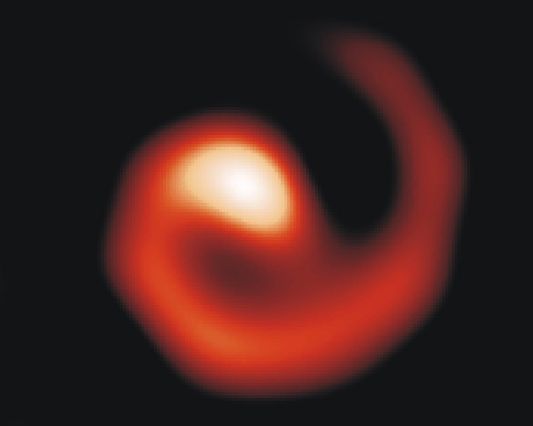
|
Credit & Copyright: U.C. Berkeley Space Sciences Laboratory,
W.M. Keck Observatory
Explanation:
Like a cosmic lawn sprinkler, dust streaming from a rotating
star system creates a pinwheel pattern in
this false color infrared image.
Astronomers discovered the surprising star dust scenario using
a sophisticated interferometer and
the 10 meter Keck I telescope
to observe the bright Wolf-Rayet star WR 104.
Wolf-Rayet stars are thought to be massive objects on
the brink of a cataclysmic supernova explosion - having grown
so hot and bright that their intense
light begins to drive material away in a stellar wind.
The problem is, their starlight would also be so intense that any
dust flakes should be destroyed!
A possible
solution to this
dusty dilemma
is that a companion star exists hidden in the
bright central region,
generating wind interactions which shield
a relatively narrow dust forming region from the light of WR 104.
As the binary system rotates,
the spray of surviving dust particles appears to spiral outward.
|
January February March April May June July August September October November December |
| ||||||||||||||||||||||||||||||||||||||||||||||||
NASA Web Site Statements, Warnings, and Disclaimers
NASA Official: Jay Norris. Specific rights apply.
A service of: LHEA at NASA / GSFC
& Michigan Tech. U.
Based on Astronomy Picture
Of the Day
Publications with keywords: dust - Wolf-Rayet star - hot star - star - binary star
Publications with words: dust - Wolf-Rayet star - hot star - star - binary star
See also:
- APOD: 2025 August 28 Á Galaxies, Stars, and Dust
- APOD: 2025 August 10 Á Zodiacal Road
- APOD: 2025 June 11 Á 25 Brightest Stars in the Night Sky
- APOD: 2025 March 17 Á Thors Helmet
- APOD: 2025 February 3 Á Wolf Rayet Star 124: Stellar Wind Machine
- APOD: 2025 January 29 Á Dust Shells around WR 140 from Webb
- Young Stars, Dark Nebulae
